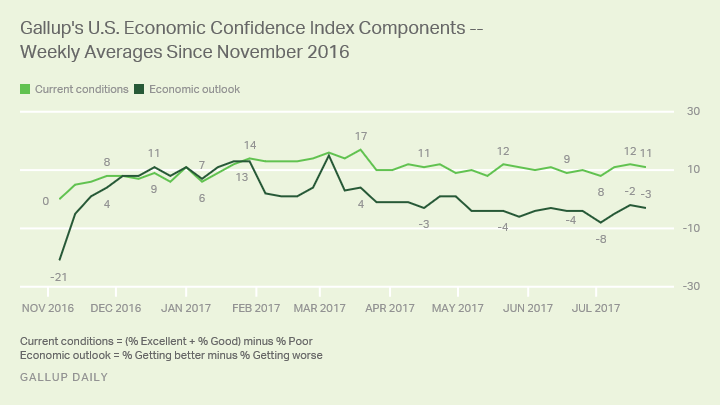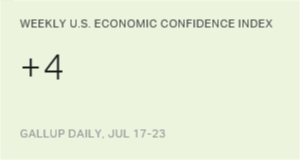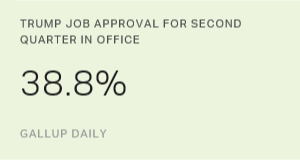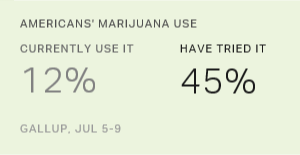Story Highlights
- Index was +4 last week, similar to past weeks
- Confidence weaker now but stronger than before election
- Current conditions at +11; economic outlook at -3
WASHINGTON, D.C. -- Americans continue to evaluate the economy slightly more positively than negatively, with Gallup's U.S. Economic Confidence Index averaging +4 last week. Since late March, Americans' assessments of the economy have been largely stable, with weekly averages of Gallup's U.S. Economic Confidence Index typically ranging between +3 and +5.

Though Americans remain optimistic about the state of the economy, this sentiment is not as strong as it was in the weeks just before and after Donald Trump's presidential inauguration, when the index hit +10 or higher several times.
The index peaked at +16 in early March in an apparent reaction to the Dow Jones finishing above 21,000 for the first time ever and Trump's speech before Congress that, among other things, outlined the president's economic agenda. Shortly after that, confidence dipped below +10, and the index has climbed no higher than +5 in the past 13 weeks. But even if economic confidence is weaker now compared with the first two months of the Trump presidency, it remains well above the dreary economic attitudes that prevailed in the run-up to the 2016 presidential election.
Gallup's U.S. Economic Confidence Index is the average of two components: how Americans rate current economic conditions and whether they believe the economy is improving or getting worse. The index has a theoretical maximum of +100 if all Americans were to say the economy is doing well and improving, and a theoretical minimum of -100 if all were to say the economy is doing poorly and getting worse.
Last week, the current conditions component stood at +11, with 33% of Americans describing the economy as "excellent" or "good," and 22% describing it as "poor." The current conditions component was +12 the week before.
The outlook component, meanwhile, was at -3 last week, based on 45% saying economic conditions in the country were "getting better," and 48% saying they were "getting worse." One week earlier, the outlook component measured -2.

Bottom Line
While Americans remain positive about the economy, their confidence is not as strong as it was in the weeks leading up to and just after Trump's inauguration. Partisanship is a major factor in Americans' decreased confidence. Just as Republicans' surging confidence in the economy right after the election helped propel Gallup's index out of negative territory, a slump in Democrats' confidence, which became more apparent after Trump became president, has tugged the index down from its recent highs. Last week, economic confidence among Americans who identify as Republican or independents who lean Republican measured +42, while confidence among Democrats or independents who lean Democratic was -26.
At the same time, Trump's lack of progress in checking off items on his economic agenda may be another reason why confidence remains notably below its recent high. Of the two components that make up Gallup's U.S. Economic Confidence Index, the economic outlook component has fallen the most significantly since early May, revealing a growing concern for the future direction of the economy.
On Sunday, the International Monetary Fund lowered its forecast for U.S. economic growth this year. The main reason for this downward revision was the lack of success the federal government has had so far in implementing economic policy items such as improving U.S. infrastructure. For some Americans, tangible results may also be required to jump-start their sense of economic optimism.
These data are available in Gallup Analytics.
Gallup.com reports results from these indexes in daily, weekly and monthly averages and in Gallup.com stories. Complete trend data are always available to view in the following charts:
Daily: Employment, Economic Confidence, Job Creation, Consumer Spending
Weekly: Employment, Economic Confidence, Job Creation, Consumer Spending
Read more about Gallup's economic measures.
View our economic release schedule.
Survey Methods
Results for this Gallup poll are based on telephone interviews conducted July 17-23, 2017, on the Gallup U.S. Daily survey, with a random sample of 3,549 adults, aged 18 and older, living in all 50 U.S. states and the District of Columbia. For results based on the total sample of national adults, the margin of sampling error is ±2 percentage points at the 95% confidence level. All reported margins of sampling error include computed design effects for weighting.
Each sample of national adults includes a minimum quota of 70% cellphone respondents and 30% landline respondents, with additional minimum quotas by time zone within region. Landline and cellular telephone numbers are selected using random-digit-dial methods.
Learn more about how the Gallup U.S. Daily works.




